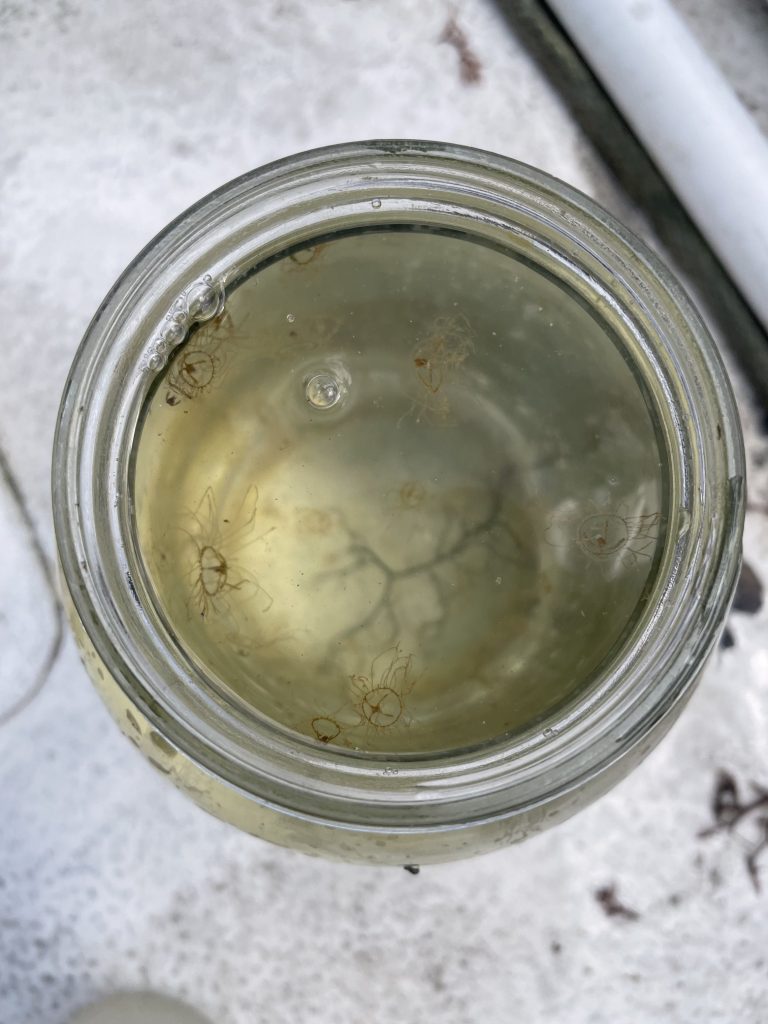
Clinging jellyfish found in Barnegat Bay and the Metedeconk River, June 2024. (Photo: Dr. Paul Bologna)
A noted jellyfish expert who has been studying the entrance of the tiny-but-dangerous “clinging jellyfish” to the Shore area for several years, found more than 300 of the creatures during a sweep last week in the Metedeconk River and northern Barnegat Bay.
Dr. Paul Bologna, a marine biologist at Montclair State University, conducted the survey with his team of graduate students within the last week. He reported his results to the state as well as shared them online, complete with photos of the species, Gonionemus vertens, which is considered invasive in New Jersey and began to appear in numbers in 2016. Locally, the species has never been found in the ocean – just back bays and rivers.
Since the state began tracking clinging jellyfish, the Department of Environmental Protection has established an online map that identifies locations that have been recently surveyed and what the searches yielded.
“Keep your eyes open and if you see any, please let us know!” Bologna said in a social media post.
First boat field day yielded around 300 clinging #jellyfish in north Barnegat Bay NJ pic.twitter.com/BxueH918uZ
— Paul A. X. Bologna (@MSUjellyfish) June 1, 2024
Clinging jellyfish range from the size of a dime to a quarter. Adults are marked by a distinctive reddish-orange to yellowish cross within their translucent bodies. To date, no human being has ever died due to a sting from a clinging jellyfish, said Bologna, but they pack an extremely powerful sting that often results in victims having to take a trip to the hospital.
Those who are stung by a clinging jellyfish will experience an initial burning sensation, but in many cases the reaction will get progressively worse before it gets better. The official instructions from the DEP for responding to clinging jellyfish stings include rinsing the area with saltwater and removing any remaining tentacle materials using gloves, a plastic card or a thick towel.
“If symptoms persist or pain increases instead of subsiding, seek prompt medical attention,” the state agency said.
So far, the initial surveys completed this year show the season “starting with a bang,” said Bologna, explaining that clinging jellyfish get their names from their behavior – they “cling” to blades of grass, sunken reeds and tree branches hanging in the water. When disturbed, they may sting.

Clinging jellyfish found in Barnegat Bay and the Metedeconk River, June 2024. (Photo: Dr. Paul Bologna)
Over the last several years, the northern reaches of the bay as well as the Metedeconk River have been the hot spots for the species, however state data shows they have proliferated along the entire length of the bay, from Brick to Long Beach Island. Particular locations where many have been identified are in plant-rich areas in the river off Princeton Avenue in Brick and adjacent lagoons in Point Pleasant, as well as locations in the northern bay – including areas near F-Cove, a popular gathering spot for boaters which has grassy shores.
The jellyfish are normally found from mid-May to late July, or until bay water temperatures reach or exceed 82 degrees Fahrenheit.

Advertisement

Seaside Heights & Seaside Park
Seaside Heights School Board Seeking More Participation, Will Change Meeting Times

Police, Fire & Courts
Seaside Park Man, 68, Charged in Fatal Crash With Pedestrian

Ortley Beach & North Beaches
Lottery Ticket Worth $10K Sold at Ortley Beach Acme

Ortley Beach & North Beaches
Abandoned Private Island ‘Mansion’ in Barnegat Bay Poised for Demolition







